Papers by Hansjürg Leibundgut

Energy and Buildings, 2014
ABSTRACT This research presents energy and exergy analyses of a new decentralized ventilation sys... more ABSTRACT This research presents energy and exergy analyses of a new decentralized ventilation system to adapt to the hot and humid climate compared to general centralized ventilation systems. A zone model of an office building was applied for a heat pump cooling system in Singapore. The cooling load capacity of the zone model was simulated using the building energy simulation software “TRNSYS” and energy and exergy analyses of the new ventilation system were carried out through numerical calculations based on the measured cooling load capacity. An effective energy solution for buildings was to increase cooling and ventilation efficiency. The energy and exergy analyses evaluated the performance of the various cooling systems. The research revealed that the new decentralized ventilation system adapted to the hot and humid climate had better performance compared to a centralized all-air system and to a chilled ceiling with centralized air handling unit system.

Building and Environment, 2015
ABSTRACT This paper proposes a novel ventilation strategy for capturing CO2 with scheduled occupa... more ABSTRACT This paper proposes a novel ventilation strategy for capturing CO2 with scheduled occupancy diversity, and changes in recirculating ratio and infiltration rate. While many publications have described filters and a lamp that can efficiently capture and remove most pollutants (such as VOCs, dust, odors and viruses) to levels equivalent to those of conventional air dilution systems, no such system exists for CO2. This paper evaluates a strategy to recirculate air in the breathing zone through simulations with occupancy diversity factors from ASHRAE 90.1-2004 and Duarte et al.’s results for weekdays from 6 AM to 9 PM to evaluate a possibility of implementing a CO2 capture device. Using a lower indoor air recirculation ratio in spaces with high CO2 concentration is more effective at reducing CO2 concentration in the breathing zone. The results indicate that maximizing the air recirculation ratio by using the CO2 capturing unit could replace conventional air ventilation systems by sufficiently reducing the concentration of CO2 and supplying enough oxygen for occupational safety and health. Such a system could save air cooling or heating energy in buildings in hot or cold days or seasons, or when there are high outdoor pollution levels for a limited period of time.
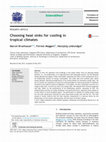
Frontiers of Architectural Research, 2013
Efforts to limit CO 2 emissions from buildings in the tropics either focus on reducing energy dem... more Efforts to limit CO 2 emissions from buildings in the tropics either focus on reducing energy demand, i.e., air-conditioning, or on replacing fossil with renewable sources. The link between energy demand and supply is often overlooked, especially the effect of the temperature lift of air-conditioning systems on energy consumption. But while heat and humidity gains define energy demand, operating temperatures of the system define the necessary energy input. We aim to transfer our experience of using the LowEx paradigm for heat pump systems in moderate climates to the tropical climate of Singapore. In this paper, we took a systematic overview of a range of heat sinks, to which we refer to as anergy sinks. We analysed their thermal properties and their effect on the performance of air-conditioning systems, expressed as COP. The predominantly used dry air-cooled condenser units performed worst, especially when subject to a stack effect in (semi-)confined spaces. The performance is highest for cooling towers using the wet bulb temperature followed by water body based anergy sinks and the soil. The wide spread of results confirms that the heat rejection temperature is a decisive factor for the performance of the overall cooling system and the input of primary energy.

Building and Environment, 2014
The deployment of low exergy concepts in buildings, which promotes high temperature cooling HVAC ... more The deployment of low exergy concepts in buildings, which promotes high temperature cooling HVAC systems introduces alternative solutions in the tropical climate. This study evaluates the performance of a decentralized dedicated outdoor air system combined with a radiant cooling system (decentralized DOAS-RCS) in terms of occupant thermal comfort and indoor air quality for the tropical context. Different sets of operational scenarios (experiments) have been conducted in the BubbleZERO laboratory to realize the impact of system related parameters like ventilation rate and supply chilled water temperature on thermal comfort and indoor air quality. The results show that supply chilled water temperature and space cooling load have strong impacts respectively on the capacity of decentralized units and cooling panel, which consequently influence indoor air condition. Indoor air was predicted to be in comfort range (-0.2 < PMV < 0.2) only at specific periods of the day and an automatic control was required to modulate the system under various indoor and outdoor conditions. Main challenges of implementing DDOAS coupled with radiant cooling in the tropics include the condensation risk on the radiant panels, non-uniformity of panel surface temperature and low air movement inside the space.
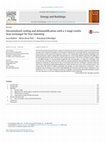
This article presents the performance study of a novel decentralized ventilation system for hot a... more This article presents the performance study of a novel decentralized ventilation system for hot and humid climates such as found in Singapore. Decentralized ventilation has a great potential for reducing pressure losses because of the short travel distances of the air. The combination of decentralized ventilation with high temperature radiant cooling offers the potential for a very energy efficient operation of buildings in hot and humid climates and to decrease their exergy destruction. Core of the ventilation system studied is a modified design of a decentralized ventilation unit incorporating a 3-stage heat exchanger. This particular heat exchanger setup ensures sufficient cooling capacity for dehumidification and offers free energy for reheating. In the process of the air treatment, the two heat exchangers' upstream takes the roles of pre-cooling and cooling/dehumidification while the third one covers the reheating process. The results show that with the studied ventilation unit outdoor air with temperatures around 30 • C and a humidity ratio of 20 g/kg can be chilled, dehumidified and reheated such that target conditions in the supply air of 14-15 • C and 8-9 g/kg are achieved. In addition, this novel decentralized ventilation system can save around 4-5% of total cooling energy demand due to free reheating.
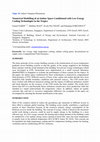
The basic principle of low exergy building systems is the minimization of excess temperature grad... more The basic principle of low exergy building systems is the minimization of excess temperature gradients across building systems so that the quality of the energy supplied to the building better matches with the actual demand of the building. Several low exergy technologies which were developed at ETH, Switzerland were implemented in a small research laboratory (BubbleZERO) in Singapore to evaluate the performance of these systems for the tropics. In this paper, the indoor space conditioned by these technologies is analysed by computational fluid dynamics (CFD). Different sources of heat, water vapour and carbon dioxide have been modelled with suitable boundary conditions and emission sources., The CFD results have been verified with different numerical settings and the impact of different turbulence models and mesh densities on the accuracy of the CFD results has been studied. The results have shown that SST k-ω and Reynolds Stress turbulence models have close predictions while the s...
SUMMARY Typical infrastructure in office buildings does not facilitate the creation of a sustaina... more SUMMARY Typical infrastructure in office buildings does not facilitate the creation of a sustainable building, effectively using energy, materials, and space. One must recognize that sustainability doesn&amp;amp;amp;amp;amp;amp;amp;amp;amp;amp;amp;amp;amp;amp;amp;amp;amp;amp;amp;amp;amp;amp;amp;amp;amp;amp;amp;amp;amp;amp;amp;amp;amp;amp;amp;amp;amp;amp;amp;amp;amp;amp;amp;amp;amp;amp;amp;amp;amp;amp;amp;amp;#39;t only refer to the use of energy, but also to spatial quality, user comfort, and ease of facility management. Different from the commonplace hierarchical systems, our goal is to distribute infrastructure such that
Energy and Buildings, 2012
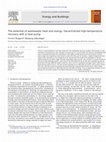
Energy and Buildings, 2011
There is a large potential in the heat losses from the wastewater leaving a building. We present ... more There is a large potential in the heat losses from the wastewater leaving a building. We present a novel concept for recovering this heat. Instead of recovering it in a mixed state, the recovery immediately after use is evaluated. This allows the exploitation of the higher temperatures found at the points of warm water usage. By integrating a heat pump to utilize this heat, we can produce a higher temperature heat supply while maintaining a low temperature-lift requirement. This leads to the possibility of directly regenerating the hot water supply through wastewater heat recovery. The concept is a result of research into low exergy building systems, and is part of the IEA ECBCS Annex 49. We have modeled the annual performance of two different system scenarios, which result in a potential average annual coefficient of performance (COP) of over 6. The first scenario supplies up to 4400 kWh of heat for all hot water events with only 790 kWh of electricity, while the second scenario regenerated directly the hot water supply just for bathroom fixtures at 2400 kWh with just 410 kWh of energy. This is a significant reduction in the demand for hot water supply of a building compared to most modern installations.
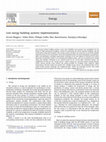
Energy, 2012
Low exergy (LowEx) building systems create more flexibility and generate new possibilities for th... more Low exergy (LowEx) building systems create more flexibility and generate new possibilities for the design of high performance buildings. Instead of maximizing the barrier between buildings and the environment using thick insulation, low exergy systems maximize the connection to the freely available dispersed energy in the environment. We present implementations of LowEx technologies in prototypes, pilots and simulations, including experimental evaluation of our new hybrid PV-thermal (PV/T) panel, operation of integrated systems in an ongoing pilot building project, and cost and performance models along with dynamic simulation of our systems based on our current office renovation project. The exploitation of what we call "anergy sources" reduces exergy use, and thus primary energy demand. LowEx systems provide many heating and cooling methods for buildings using moderate supply temperatures and heat pumps that exploit more valuable anergy sources. Our implementation of integrated LowEx systems maintains low temperature-lifts, which can drastically increase heat pump performance from the typical COP range of 3e6 to values ranging from 6 to 13.
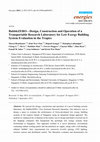
We present the design, construction and operation of a novel building systems laboratory, the Bub... more We present the design, construction and operation of a novel building systems laboratory, the BubbleZERO—Zero Emission Research Operation. Our objective was to design a space to evaluate the performance of Swiss-developed low exergy building systems in the tropical climate of Singapore using an integrated design approach. The method we employed for evaluation in the tropics was to design and build a test bed out of the shipping containers that transported the prototype low exergy systems from Switzerland to Singapore. This approach resulted in a novel laboratory environment containing radiant cooling panels and decentralized air supply, along with a self-shading, inflated “bubble” skin, experimental low emissivity (LowE) glazing, LED lighting, wireless sensors and distributed control. The laboratory evaluates and demonstrates for the first time in Singapore an integrated high-temperature cooling system with separate demand-controlled ventilation adapted for the tropics. It is a functional lab testing system in real tropical conditions. As such, the results showing the ability to mitigate the risk of condensation by maintaining a dew point below 18 °C by the separate decentralized ventilation are significant and necessary for potential future implementation in buildings. In addition, the control system provides new proof of concept for distributed wireless sensors and control for reliable automation of the systems. These key results are presented along with the integrated design process and real-life tropical operation of the laboratory.
Sustainable Cities and Society, 2012
This paper represents a unique collaboration between experts in architecture and engineering from... more This paper represents a unique collaboration between experts in architecture and engineering from around the globe to evaluate the true potential to reduce CO 2 emissions from buildings. The result of this experiment in remote collaboration between Europe, USA, Japan and China, was a summary that was generated for the Holcim Forum workshop, "Reduce CO 2 -With technology to zero emissions." This covers challenges of reducing emissions from building construction, operation and maintenance while also presenting an array of potential solutions. Here we expand on that work for the benefit of a broader audience.





Uploads
Papers by Hansjürg Leibundgut